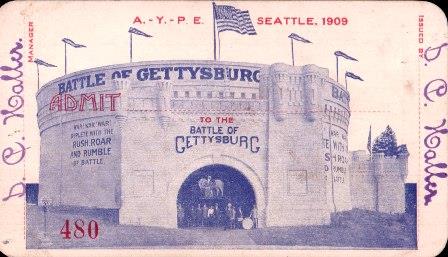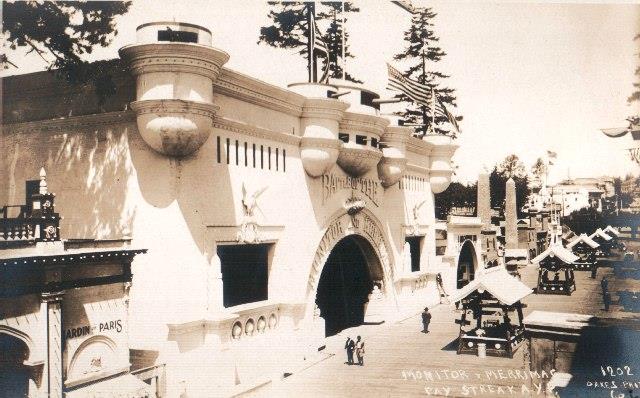Alaska-Yukon-Pacific Exposition - Images of the Fair
Gettysburg and Monitor and Merrimac Cycloramas
From the late eighteenth and nineteenth through the early twentieth century, giant circular panoramic paintings or Cycloramas represented one of the most lavish and popular forms of imagery entertainment. With standardized dimensions of 400 feet in length and fifty feet in height, they gave - and still can give - the viewer a feeling of immersion in a vast scene such as that created through IMAX films today. These complex, multi-scene creations could give one the impression of travel over miles of countryside, cityscape, or scene of battle. They required teams of skilled painters to complete, complex logistics to hang and move, and at the AYPE represented a scale of artistic entertainment probably never before experienced by most local visitors. Representative titles from the heyday of panoramic paintings include View of London, Russian Fleet at Spithead, View of Pompeii, Versailles, Battle of Atlanta, The Crucifixion of Christ, etc. In the heyday of the panoramic painting elaborate buildings were designed and built exclusively to show them; Paris alone had thirteen such theaters.
Only three cycloramas, including a different copy of The Battle of Gettysburg, can be viewed today in this country but the AYPE had two major cycloramas and at least one smaller one. The Battle of Gettysburg and The Battle of the Monitor and the Merimac were presented in separate buildings on the Pay Streak. Each reportedly cost nearly a million dollars to originally construct and and subsequently mount at the Fair. A smaller cyclorama was shown in the King County building depicting local scenes.

Pass to the Battle of Gettysburg
Because a Gettysburg - recently restored at a cost of over fifteen million dollars - is still displayed today, more information is available about it. According the the National Park Service,
The "Cyclorama of the Battle of Gettysburg" opened to the public in Chicago in 1883, complete with a three-dimensional earthen foreground littered with the relics of battle, stone walls, shattered trees and broken fences. Visitors were awed by the painting's spectacular realism. Veterans of the battle, including General John Gibbon whose troops threw back Pickett's Division on July 3, wrote of its splendor. Philippoteaux's "Battle of Gettysburg" received such public acclaim that he was contracted to paint a second version of his monumental work, which opened in Boston one year later. Once again Philippoteaux's "Battle of Gettysburg" cyclorama received critical review and hundreds of visitors crowded the specially-built cyclorama building on Tremont Street to view the incredible painting and listen to a lecture on the battle. (NPS web site).
There were four copies of Gettysburg; it is not known which was shown in Seattle although it was probably not the Boston one. It is interesting to note that the panoramic painting form has never completely died out; although there are only twenty or so from the classic era that can be viewed worldwide reportedly new ones were still being created in the late twentieth century.

Oakes photo Co.
Monitor And Merrimac on the Pay Streak


